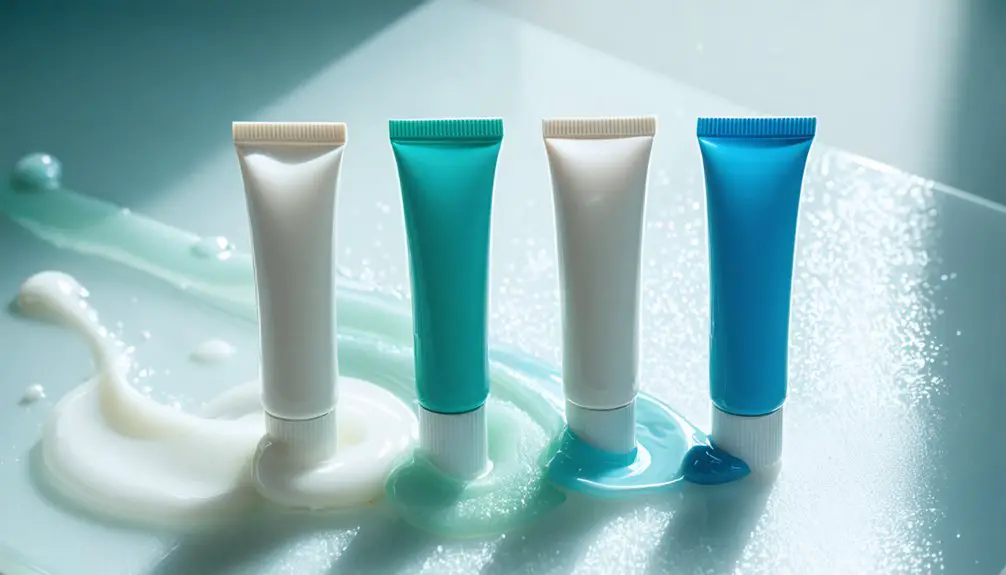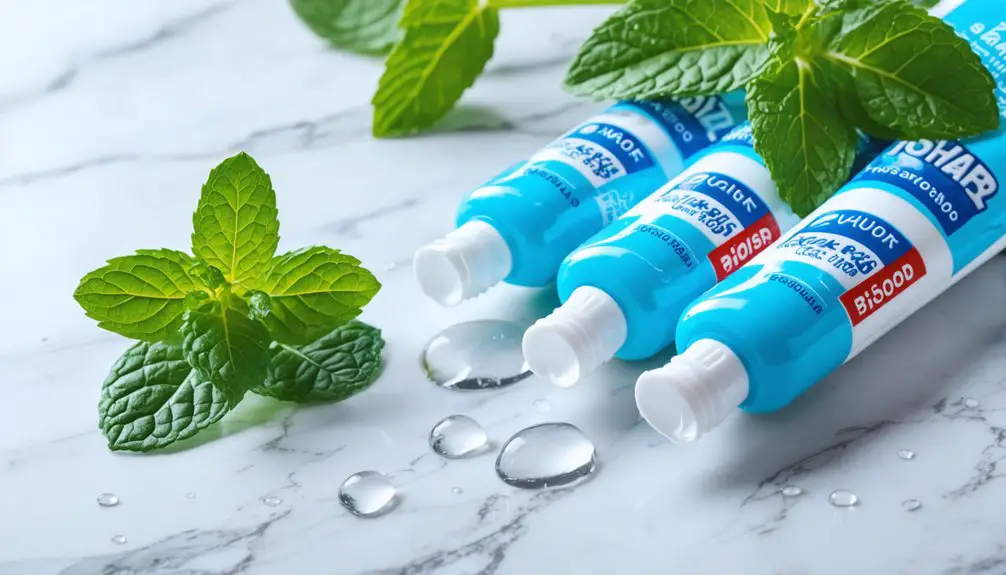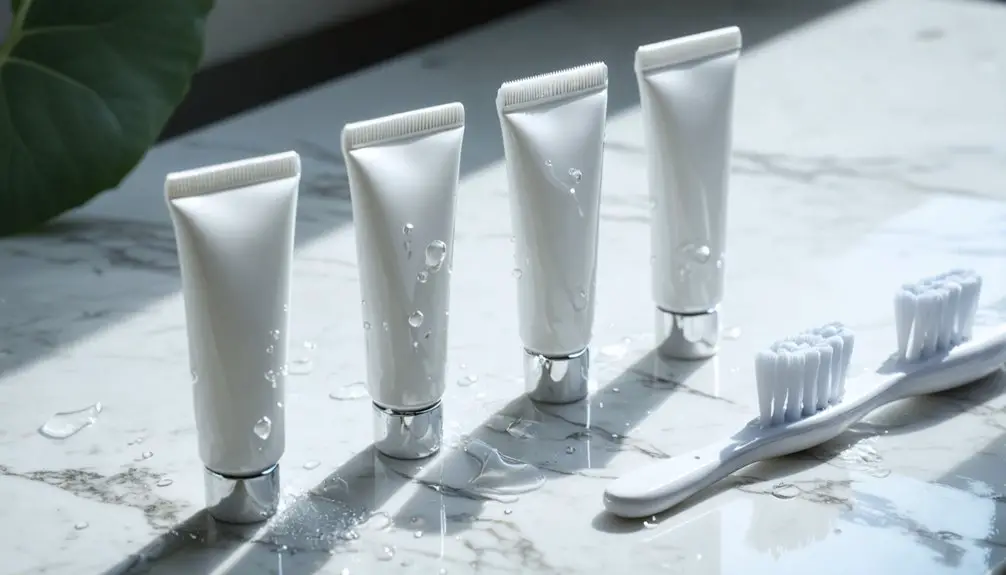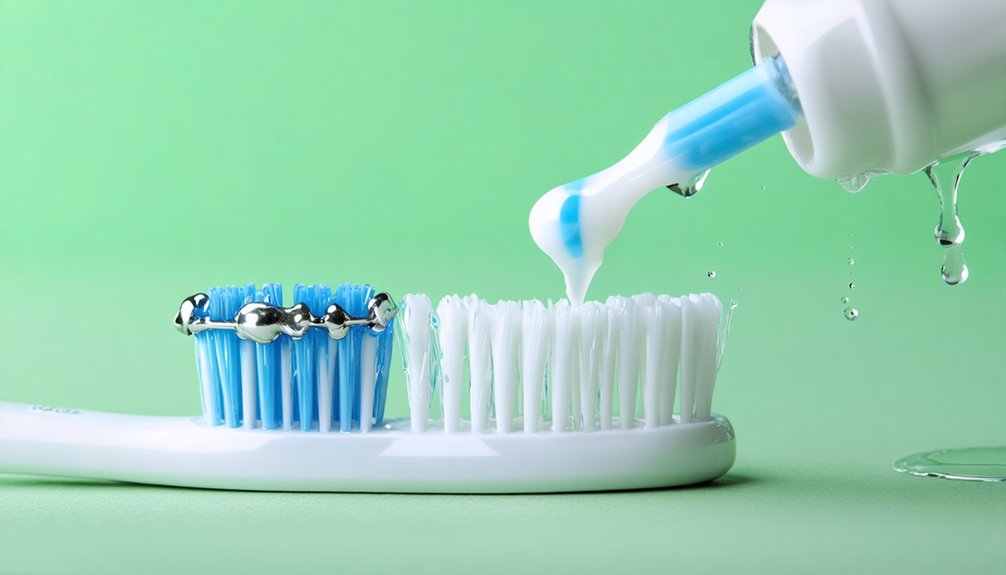You’ll find effective relief through specialized gentle whitening toothpastes designed for sensitive teeth. Top-rated options include Sensodyne Clinical White, which brightens teeth by two shades within two weeks, and Crest 3D White Brilliance Gentle, which protects enamel while whitening. Look for key ingredients like potassium nitrate and low-abrasion silica for ideal results. Understanding the right formula and ingredients for your specific sensitivity level will guarantee successful whitening outcomes.
Key Takeaways
- Sensodyne Clinical White delivers noticeable whitening results within two weeks while protecting sensitive teeth with potassium nitrate.
- Pronamel Gentle Whitening uses low-abrasion silica for safe stain removal without sodium lauryl sulfate.
- Crest 3D White Brilliance Gentle combines enamel protection with whitening agents suitable for sensitive teeth.
- Tom’s of Maine offers natural whitening with xylitol, ideal for those seeking fluoride-free sensitivity relief.
- Sensodyne Extra Whitening contains specialized desensitizing ingredients while removing surface stains through gentle polishing action.
Understanding Gentle Whitening for Sensitive Teeth
While many people desire whiter teeth, those with sensitivity require a more thoughtful approach to achieving their cosmetic goals. Understanding gentle whitening means recognizing that it’s about gradual stain removal rather than aggressive bleaching treatments that can worsen discomfort. For optimal results, a user-friendly experience ensures proper application and effectiveness of whitening products.
Sensodyne Gentle Whitening provides specialized care for those with sensitive teeth who want to achieve a brighter smile. Gentle polishing agents work to remove surface stains while preserving your enamel health, which is essential for managing sensitivity.
You’ll find that these specialized formulations focus on twice-daily consistent care to achieve visible results without compromising comfort. The process emphasizes maintaining your natural tooth whiteness through careful stain removal rather than chemical alterations.
Key Ingredients That Make a Difference
The science behind gentle whitening toothpastes lies in their carefully selected ingredients that balance cosmetic improvement with sensitivity protection.
Modern whitening formulas represent a delicate balance, combining gentle yet effective ingredients that brighten teeth while safeguarding sensitive smiles.
You’ll find milder whitening agents like carbamide peroxide and hydrated silica, which effectively remove stains while minimizing irritation. These work alongside sensitivity relief compounds such as potassium nitrate, which calms tooth nerve responses, and sodium fluoride, which strengthens your enamel. Regular dental checkups help monitor how well these ingredients work for your specific sensitivity needs.
For maximum protection, look for formulations containing calcium compounds that help repair micro-pores in your enamel. Nano-hydroxyapatite ingredients are especially effective at rebuilding and strengthening sensitive tooth surfaces.
Many sensitive whitening toothpastes also exclude harsh ingredients like sodium lauryl sulfate (SLS) and incorporate low-abrasion silica blends.
These thoughtfully combined ingredients guarantee you can achieve a brighter smile without compromising your teeth’s comfort or health.
Top-Rated Sensitive Whitening Toothpaste Brands
Leading sensitive whitening toothpaste brands have established their reputation through clinically proven formulations that balance stain removal with nerve protection.
For ideal sensitive enamel care, Sensodyne Clinical White delivers remarkable whitening effectiveness, brightening teeth by two shades within two weeks while maintaining 24-hour sensitivity protection. Regular dental cleanings are essential for maintaining optimal whitening results and preventing deep stains.
You’ll find Sensodyne Pronamel Gentle Whitening particularly suitable if you’re seeking a low-abrasive option without sodium lauryl sulfate.
Crest 3D White Brilliance Gentle offers specialized protection for sensitive enamel, while Tom’s of Maine provides a natural alternative with xylitol for those preferring fluoride-free options. The pack of 2 is available at an affordable $6.40.
For enhanced sensitivity relief, Sensodyne Extra Whitening contains potassium nitrate that quickly addresses nerve sensitivity while gradually removing surface stains.
How to Choose the Right Formula for Your Needs
Selecting an effective whitening toothpaste for sensitive teeth requires careful consideration of your specific oral health needs and sensitivity triggers.
Start by evaluating your sensitivity levels – if you experience sharp pain with hot or cold stimuli, choose formulas with potassium nitrate or strontium chloride. For mild sensitivity, look for toothpaste types with low-abrasion silica and fluoride compounds.
Check the RDA value – opt for products under 70 if you have significant sensitivity. Consider options like Sensodyne Extra Whitening which specifically targets both stain removal and sensitivity relief. The comparable formula of Equate Extra Whitening provides similar benefits at a more affordable price point.
If you’re concerned about chemical irritants, select SLS-free formulas with natural whitening ingredients. Those with gum recession should prioritize gentle formulas containing nano-hydroxyapatite for enamel protection.
Always verify that your chosen product carries ADA certification to confirm it meets safety standards for sensitive teeth.
Best Practices for Safe and Effective Whitening
While achieving a brighter smile remains a common goal, protecting sensitive teeth during whitening requires careful adherence to safety protocols and best practices.
For safe whitening, always follow product instructions precisely and use formulas specifically designed for sensitive teeth, which often contain potassium nitrate or fluoride for enamel protection. Active ingredients like hydrogen peroxide break down complex staining molecules to create a whiter appearance. Surface stains from coffee and tobacco can be effectively removed with whitening toothpaste.
Start with gentle whitening sessions every other day to allow your teeth time to recover. Use desensitizing toothpaste before and after treatments, and maintain proper oral hygiene throughout the process.
If you experience severe sensitivity or gum irritation, discontinue use immediately and consult your dentist.
For ideal results with minimal risk, consider professional treatments or custom-fitted trays rather than generic over-the-counter products, especially if you have particularly sensitive teeth.
Frequently Asked Questions
Can I Use Whitening Toothpaste While Wearing Braces or Dental Appliances?
You can use whitening toothpaste with braces, but it’s best to choose gentle formulas and consult your orthodontist first. For braces safety, avoid aggressive brushing and consider waiting until after treatment for ideal results.
How Long Should I Wait After Teeth Cleaning Before Using Whitening Toothpaste?
Like protecting a fresh canvas, you’ll want to wait 30-60 minutes after teeth cleaning before using whitening toothpaste. This allows your enamel to stabilize, maximizing whitening effects and minimizing sensitivity.
Will Whitening Toothpaste Remove Medication-Induced Tooth Stains?
You won’t see significant improvement in medication-induced tooth stains with whitening toothpaste alone. These stains are deeper than surface level, so you’ll need professional treatments for effective removal.
Can Children Use Sensitive Teeth Whitening Toothpaste?
Due to safety concerns, you shouldn’t give children whitening toothpaste until permanent teeth fully develop. Follow age recommendations from pediatric dentists, who typically advise waiting until at least 12-13 years old.
Does Drinking Coffee Immediately After Brushing Reduce Whitening Effectiveness?
Coffee stains can form within 24 hours of brushing, greatly reducing whitening effectiveness. You’ll protect your smile best by waiting 48-72 hours after whitening treatments before enjoying your coffee.
References
- https://www.tribecasmiles.com/top-whitening-toothpastes-for-sensitive-teeth-2025
- https://icybeardental.com/products/sensitive-teeth-whitening-toothpaste
- https://www.cnet.com/health/personal-care/best-whitening-toothpaste/
- https://www.sensodyne.com/en-gb/oral-health-tips/whitening-sensitive-teeth/managing-your-sensitive-teeth/
- https://www.kirklanddentalexcellence.com/blog/health/best-toothpaste-for-teeth-whitening/
- https://www.sensodyne.com/en-gb/oral-health-tips/whitening-sensitive-teeth/what-to-know/
- https://www.walmart.com/ip/Sensodyne-Pronamel-Gentle-Whitening-Enamel-Toothpaste-for-Sensitive-Teeth-Alpine-Breeze-2-7-Oz/43711290
- https://www.target.com/p/pronamel-gentle-whitening-toothpaste/-/A-13356878
- https://crest.com/en-us/oral-care-products/toothpaste/gum-sensitivity-repair-gentle-whitening-toothpaste
- https://www.nogapsdental.com/blog/best-toothpaste-for-teeth-whitening/



